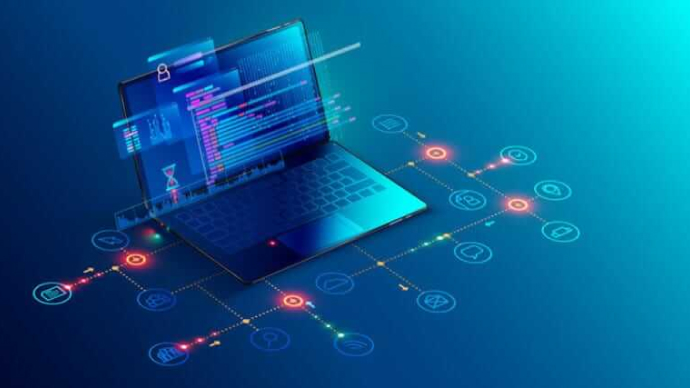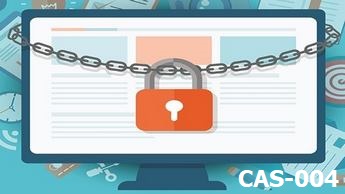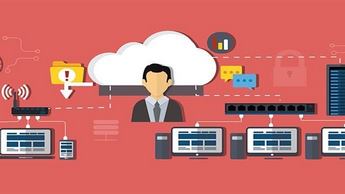
CAS-004: CompTIA Advanced Security Practitioner (CASP+) CAS-004
PDFs and exam guides are not so efficient, right? Prepare for your CompTIA examination with our training course. The CAS-004 course contains a complete batch of videos that will provide you with profound and thorough knowledge related to CompTIA certification exam. Pass the CompTIA CAS-004 test with flying colors.

Curriculum for CAS-004 Certification Video Course
| Name of Video | Time |
|---|---|
 1. Data Considerations (OBJ 4.3) |
1:00 |
 2. Data Security (OBJ. 4.3) |
4:00 |
 3. Data Classification (OBJ. 4.3) |
3:00 |
 4. Data Types (OBJ. 4.3) |
5:00 |
 5. Data Retention (OBJ. 4.3) |
7:00 |
 6. Data Destruction (OBJ. 4.3) |
3:00 |
 7. Data Ownership (OBJ. 4.3) |
6:00 |
 8. Data Sovereignty (OBJ. 4.3) |
3:00 |
| Name of Video | Time |
|---|---|
 1. Risk Management (OBJ 4.1) |
2:00 |
 2. Risk Strategies (OBJ. 4.1) |
5:00 |
 3. Risk Management Lifecycle (OBJ. 4.1) |
12:00 |
 4. Risk Types (OBJ. 4.1) |
3:00 |
 5. Risk Handling (OBJ. 4.1) |
9:00 |
 6. Risk Tracking (OBJ. 4.1) |
5:00 |
 7. Risk Assessment (OBJ. 4.1) |
18:00 |
 8. When Risk Management Fails (OBJ. 4.1) |
4:00 |
| Name of Video | Time |
|---|---|
 1. Policies and Frameworks (OBJ. 4.1 & 4.3) |
1:00 |
 2. Policies (OBJ. 4.1) |
12:00 |
 3. Frameworks (OBJ. 4.1) |
5:00 |
 4. Regulations (OBJ. 4.3) |
8:00 |
 5. Standards (OBJ. 4.3) |
6:00 |
 6. Contracts and Agreements (OBJ. 4.3) |
9:00 |
 7. Legal Considerations (OBJ. 4.3) |
7:00 |
 8. Integrating Industries (OBJ. 4.3) |
3:00 |
| Name of Video | Time |
|---|---|
 1. Business Continuity (OBJ 4.4) |
1:00 |
 2. Business Continuity Plan (OBJ 4.4) |
14:00 |
 3. Business Impact Analysis (OBJ 4.4) |
14:00 |
 4. Privacy Impact Assessment (OBJ 4.4) |
4:00 |
 5. Incident Response Plan (OBJ 4.4) |
11:00 |
 6. Testing Plans (OBJ 4.4) |
7:00 |
| Name of Video | Time |
|---|---|
 1. Risk Strategies (OBJ 4.1) |
2:00 |
 2. Asset Value (OBJ 4.1) |
4:00 |
 3. Access Control (OBJ 4.1) |
6:00 |
 4. Aggregating Risk (OBJ 4.1) |
3:00 |
 5. Scenario Planning (OBJ 4.1) |
8:00 |
 6. Security Controls (OBJ 4.1) |
9:00 |
 7. Security Solutions (OBJ 4.1) |
9:00 |
 8. Cost of a Data Breach (OBJ 4.1) |
6:00 |
| Name of Video | Time |
|---|---|
 1. Vendor Risk (OBJ 4.2) |
4:00 |
 2. Business Models (OBJ 4.2) |
11:00 |
 3. Influences (OBJ 4.2) |
7:00 |
 4. Organizational Changes (OBJ 4.2) |
6:00 |
 5. Shared Responsibility Model (OBJ 4.2) |
5:00 |
 6. Viability and Support (OBJ 4.2) |
11:00 |
 7. Dependencies (OBJ 4.2) |
5:00 |
 8. Considerations (OBJ 4.2) |
11:00 |
 9. Supply Chain (OBJ 4.2) |
6:00 |
| Name of Video | Time |
|---|---|
 1. Securing Networks (OBJ 1.1) |
7:00 |
 2. Switches (OBJ 1.1) |
7:00 |
 3. Routers (OBJ 1.1) |
8:00 |
 4. Wireless and Mesh (OBJ 1.1) |
3:00 |
 5. Firewalls (OBJ 1.1) |
12:00 |
 6. Configuring Firewalls (OBJ 1.1) |
7:00 |
 7. Proxies (OBJ 1.1) |
7:00 |
 8. Gateways (OBJ 1.1) |
5:00 |
 9. IDS and IPS (OBJ 1.1) |
6:00 |
 10. Network Access Control (NAC) (OBJ 1.1) |
3:00 |
 11. Remote Access (OBJ 1.1) |
9:00 |
 12. Unified Communications (OBJ 1.1) |
19:00 |
 13. Cloud vs On-premise (OBJ 1.1) |
5:00 |
 14. DNSSEC (OBJ 1.1) |
4:00 |
 15. Load Balancer (OBJ 1.1) |
7:00 |
| Name of Video | Time |
|---|---|
 1. Securing Architectures (OBJ 1.1) |
1:00 |
 2. Traffic Mirroring (OBJ 1.1) |
4:00 |
 3. Network Sensors (OBJ 1.1) |
12:00 |
 4. Host Sensors (OBJ 1.1) |
6:00 |
 5. Layer 2 Segmentation (OBJ 1.1) |
5:00 |
 6. Network Segmentation (OBJ 1.1) |
13:00 |
 7. Implement Network Segmentation (OBJ 1.1) |
10:00 |
 8. Server Segmentation (OBJ 1.1) |
11:00 |
 9. Zero Trust (OBJ 1.1) |
7:00 |
 10. Merging Networks (OBJ 1.1) |
6:00 |
 11. Software-Defined Networking (SDN) (OBJ 1.1) |
5:00 |
| Name of Video | Time |
|---|---|
 1. Infrastructure Design (OBJ 1.2) |
1:00 |
 2. Scalability (OBJ 1.2) |
6:00 |
 3. Resiliency Issues (OBJ 1.2) |
13:00 |
 4. Automation (OBJ 1.2) |
6:00 |
 5. Performance Design (OBJ 1.2) |
6:00 |
 6. Virtualization (OBJ 1.2) |
8:00 |
 7. Securing VMs (OBJ 1.2) |
5:00 |
 8. Containerization (OBJ 1.2) |
6:00 |
| Name of Video | Time |
|---|---|
 1. Cloud and Virtualization (OBJ 1.6) |
1:00 |
 2. Cloud Deployment Models (OBJ 1.6) |
5:00 |
 3. Cloud Service Models (OBJ 1.6) |
5:00 |
 4. Deployment Considerations (OBJ 1.6) |
5:00 |
 5. Provider Limitations (OBJ 1.6) |
3:00 |
 6. Extending Controls (OBJ 1.6) |
5:00 |
 7. Provision and Deprovision (OBJ 1.6) |
3:00 |
 8. Storage Models (OBJ 1.6) |
5:00 |
 9. Virtualization (OBJ 1.6) |
8:00 |
| Name of Video | Time |
|---|---|
 1. Software Applications (OBJ 1.3) |
3:00 |
 2. Systems Development Life Cycle (OBJ 1.3) |
7:00 |
 3. Software Development Life Cycle (OBJ 1.3) |
6:00 |
 4. Development Approaches (OBJ 1.3) |
11:00 |
 5. Software Assurance (OBJ 1.3) |
9:00 |
 6. Baselins and Templates (OBJ 1.3) |
7:00 |
 7. Best Practices (OBJ 1.3) |
6:00 |
 8. Integrating Applications (OBJ 1.3) |
5:00 |
| Name of Video | Time |
|---|---|
 1. Data Security (OBJ 1.4) |
4:00 |
 2. Data Life Cycle (OBJ 1.4) |
10:00 |
 3. Data Classification (OBJ 1.4) |
7:00 |
 4. Labeling and Tagging (OBJ 1.4) |
8:00 |
 5. Deidentification (OBJ 1.4) |
11:00 |
 6. Data Encryption (OBJ 1.4) |
8:00 |
 7. Data Loss Prevention (DLP) (OBJ 1.4) |
10:00 |
 8. DLP Detection (OBJ 1.4) |
7:00 |
 9. Data Loss Detection (OBJ 1.4) |
12:00 |
 10. Auditing Files (OBJ 1.4) |
4:00 |
| Name of Video | Time |
|---|---|
 1. Authentication and Authorization (OBJ 1.5) |
2:00 |
 2. Access Control (OBJ 1.5) |
5:00 |
 3. Credential Management (OBJ 1.5) |
4:00 |
 4. Password Policies (OBJ 1.5) |
8:00 |
 5. Implementing Password Policies (OBJ 1.5) |
5:00 |
 6. Cracking Weak Passwords (OBJ 1.5) |
3:00 |
 7. Multifactor Authentication (OBJ 1.5) |
8:00 |
 8. Authentication Protocols (OBJ 1.5) |
10:00 |
 9. Federation (OBJ 1.5) |
7:00 |
 10. Root of Trust (OBJ 1.5) |
4:00 |
 11. Attestation (OBJ 1.5) |
2:00 |
 12. Identity Proofing (OBJ 1.5) |
4:00 |
| Name of Video | Time |
|---|---|
 1. Cryptography (OBJ 1.7) |
2:00 |
 2. Privacy and Confidentiality (OBJ 1.7) |
7:00 |
 3. Integrity and Non-repudiation (OBJ 1.7) |
7:00 |
 4. Compliance and Policy (OBJ 1.7) |
4:00 |
 5. Data States (OBJ 1.7) |
7:00 |
 6. Cryptographic Use Cases (OBJ 1.7) |
6:00 |
 7. PKI Use Cases (OBJ 1.7) |
9:00 |
| Name of Video | Time |
|---|---|
 1. Emerging Technology (OBJ 1.8) |
4:00 |
 2. Artificial Intelligence (AI) & Machine Learning (ML) (OBJ 1.8) |
9:00 |
 3. Deep Learning (OBJ 1.8) |
9:00 |
 4. Big Data (OBJ 1.8) |
5:00 |
 5. Blockchain & Distributed Consensus (OBJ 1.8) |
6:00 |
 6. Passwordless Authentication (OBJ 1.8) |
5:00 |
 7. Homomorphic Encryption (OBJ 1.8) |
4:00 |
 8. Virtual/Augmented Reality (OBJ 1.8) |
5:00 |
 9. 3D Printing (OBJ 1.8) |
3:00 |
 10. Quantum Computing (OBJ 1.8) |
6:00 |
| Name of Video | Time |
|---|---|
 1. Enterprise Mobility |
3:00 |
 2. Enterprise Mobility Management (EMM) (OBJ. 3.1) |
10:00 |
 3. WPA3 (OBJ. 3.1) |
7:00 |
 4. Connectivity Options (OBJ. 3.1) |
9:00 |
 5. Security Configurations (OBJ. 3.1) |
8:00 |
 6. DNS Protection (OBJ. 3.1) |
3:00 |
 7. Deployment Options (OBJ. 3.1) |
5:00 |
 8. Reconnaissance Concerns (OBJ. 3.1) |
8:00 |
 9. Mobile Security (OBJ. 3.1) |
8:00 |
| Name of Video | Time |
|---|---|
 1. Endpoint Security Controls |
2:00 |
 2. Device Hardening (OBJ. 3.2) |
9:00 |
 3. Unnecessary Services (OBJ. 3.2) |
6:00 |
 4. Patching (OBJ. 3.2) |
5:00 |
 5. Security Settings (OBJ. 3.2) |
6:00 |
 6. Mandatory Access Controls (MAC) (OBJ. 3.2) |
7:00 |
 7. Secure Boot (OBJ. 3.2) |
6:00 |
 8. Hardware Encryption (OBJ. 3.2) |
5:00 |
 9. Endpoint Protections (OBJ. 3.2) |
10:00 |
 10. Logging and Monitoring (OBJ. 3.2) |
6:00 |
 11. Configuring SIEM Agents (OBJ. 3.2) |
19:00 |
 12. Resiliency (OBJ. 3.2) |
6:00 |
| Name of Video | Time |
|---|---|
 1. Cloud Technologies |
3:00 |
 2. Business Continuity/Disaster Recovery (BC/DR) (OBJ. 3.4) |
8:00 |
 3. Cloud Encryption (OBJ. 3.4) |
5:00 |
 4. Serverless Computing (OBJ. 3.4) |
9:00 |
 5. Software-Defined Networking (SDN) (OBJ. 3.4) |
5:00 |
 6. Log Collection and Analysis (OBJ. 3.4) |
4:00 |
 7. Cloud Access Security Broker (CASB) (OBJ. 3.4) |
6:00 |
 8. Cloud Misconfigurations (OBJ. 3.4) |
11:00 |
| Name of Video | Time |
|---|---|
 1. Operational Technologies |
2:00 |
 2. Embedded Systems (OBJ. 3.3) |
10:00 |
 3. ICS and SCADA (OBJ. 3.3) |
9:00 |
 4. ICS Protocols (OBJ. 3.3) |
11:00 |
 5. Industries and Sectors (OBJ. 3.3) |
5:00 |
| Name of Video | Time |
|---|---|
 1. Hashing and Symmetric Algorithms |
1:00 |
 2. Hashing (OBJ. 3.6) |
7:00 |
 3. Calculating Hash Digests (OBJ. 3.6) |
3:00 |
 4. Message Authentication (OBJ. 3.6) |
4:00 |
 5. Symmetric Algorithms (OBJ. 3.6) |
6:00 |
 6. Stream Ciphers (OBJ. 3.6) |
5:00 |
 7. Block Ciphers (OBJ. 3.6) |
10:00 |
| Name of Video | Time |
|---|---|
 1. Asymmetric Algorithms |
2:00 |
 2. Using Asymmetric Algortihms |
9:00 |
 3. SSL/TLS and Cipher Suites (OBJ. 3.6) |
8:00 |
 4. S/MIME and SSH (OBJ. 3.6) |
7:00 |
 5. EAP (OBJ. 3.6) |
6:00 |
 6. IPSec (OBJ. 3.6) |
15:00 |
 7. Elliptic Curve Cryptography (ECC) (OBJ. 3.6) |
4:00 |
 8. Forward Secrecy (OBJ. 3.6) |
4:00 |
 9. Authenticated Encryption with Associated Data (AEAD) (OBJ. 3.6) |
2:00 |
 10. Key Stretching (OBJ. 3.6) |
5:00 |
| Name of Video | Time |
|---|---|
 1. Public Key Infrastructure |
3:00 |
 2. PKI Components (OBJ. 3.5) |
10:00 |
 3. Digital Certificates (OBJ. 3.5) |
8:00 |
 4. Using Digital Certificates (OBJ. 3.5) |
6:00 |
 5. Exploring Server Certificates (OBJ. 3.5) |
4:00 |
 6. Trust Models (OBJ. 3.5) |
4:00 |
 7. Certificate Management (OBJ. 3.5) |
3:00 |
 8. Certificate Validity (CRL and OCSP) (OBJ. 3.5) |
4:00 |
 9. Protecting Web Traffic (OBJ. 3.5) |
4:00 |
 10. Troubleshooting Certificates (OBJ. 3.7) |
5:00 |
 11. Troubleshooting Keys (OBJ. 3.7) |
4:00 |
| Name of Video | Time |
|---|---|
 1. Threat and Vulnerability Management |
2:00 |
 2. Threat Intelligence (OBJ. 2.1) |
6:00 |
 3. Threat Hunting (OBJ. 2.1) |
7:00 |
 4. Intelligence Collection (OBJ. 2.1) |
11:00 |
 5. Threat Actors (OBJ. 2.1) |
9:00 |
 6. Threat Management Frameworks (OBJ. 2.1) |
13:00 |
 7. Vulnerability Management Activities (OBJ. 2.3) |
12:00 |
 8. Security Content Automation Protocol (SCAP) (OBJ. 2.3) |
7:00 |
| Name of Video | Time |
|---|---|
 1. Vulnerability Assessments |
2:00 |
 2. Penetration Test (OBJ. 2.4) |
5:00 |
 3. PenTest Steps (OBJ. 2.4) |
7:00 |
 4. PenTest Requirements (OBJ. 2.4) |
11:00 |
 5. Code Analysis (OBJ. 2.4) |
8:00 |
 6. Protocol Analysis (OBJ. 2.4) |
8:00 |
 7. TCPDump (OBJ. 2.4) |
8:00 |
 8. Wireshark (OBJ. 2.4) |
10:00 |
 9. Nmap (OBJ. 2.4) |
11:00 |
 10. Analysis Utilities (OBJ. 2.4) |
5:00 |
 11. Vulnerability Scanning (OBJ. 2.4) |
9:00 |
 12. Analyzing Scan Outputs (OBJ. 2.4) |
14:00 |
| Name of Video | Time |
|---|---|
 1. Risk Reduction |
2:00 |
 2. Deceptive Technologies (OBJ. 2.6) |
5:00 |
 3. Security Data Analytics (OBJ. 2.6) |
8:00 |
 4. Preventative Controls (OBJ. 2.6) |
5:00 |
 5. Application Controls (OBJ. 2.6) |
10:00 |
 6. Security Automation (OBJ. 2.6) |
11:00 |
 7. Physical Security (OBJ. 2.6) |
7:00 |
 8. Lock Picking (OBJ. 2.6) |
2:00 |
| Name of Video | Time |
|---|---|
 1. Analyzing Vulnerabilities |
1:00 |
 2. Race Conditions (OBJ. 2.5) |
5:00 |
 3. Buffer Overflows (OBJ. 2.5) |
12:00 |
 4. Buffer Overflow Attack (OBJ. 2.6) |
6:00 |
 5. Authentication and References (OBJ. 2.5) |
6:00 |
 6. Ciphers and Certificates (OBJ. 2.5) |
11:00 |
 7. Improper Headers (OBJ. 2.5) |
6:00 |
 8. Software Composition (OBJ. 2.5) |
10:00 |
 9. Vulnerable Web Applications (OBJ. 2.5) |
12:00 |
| Name of Video | Time |
|---|---|
 1. Attacking Vulnerabilities |
1:00 |
 2. Directory Traversals (OBJ. 2.5) |
10:00 |
 3. Cross-Site Scripting (XSS) (OBJ. 2.5) |
9:00 |
 4. Cross-Site Request Forgery (CSRF) (OBJ. 2.5) |
7:00 |
 5. SQL Injections (OBJ. 2.5) |
7:00 |
 6. XML Injections (OBJ. 2.5) |
6:00 |
 7. Other Injection Attacks (OBJ. 2.5) |
4:00 |
 8. Authentication Bypass (OBJ. 2.5) |
7:00 |
 9. Web Application Vulnerabilities (OBJ. 2.5) |
9:00 |
 10. VM Attacks (OBJ. 2.5) |
5:00 |
 11. Network Attacks (OBJ. 2.5) |
11:00 |
 12. Analyzing Web Applications (OBJ. 2.5) |
16:00 |
 13. Social Engineering (OBJ. 2.5) |
7:00 |
 14. Phishing Campaigns (OBJ. 2.5) |
5:00 |
| Name of Video | Time |
|---|---|
 1. Indicators of Compromise |
2:00 |
 2. Types of IoCs (OBJ. 2.2) |
4:00 |
 3. PCAP Files (OBJ. 2.2) |
4:00 |
 4. Conduct Packet Analysis (OBJ. 2.2) |
6:00 |
 5. NetFlow (OBJ. 2.2) |
7:00 |
 6. Logs (OBJ. 2.2) |
7:00 |
 7. IoC Notifications (OBJ. 2.2) |
8:00 |
 8. Response to IoCs (OBJ. 2.2) |
5:00 |
 9. Security Appliances (OBJ. 2.2) |
16:00 |
| Name of Video | Time |
|---|---|
 1. Incident Response |
1:00 |
 2. Triage (OBJ. 2.7) |
8:00 |
 3. Communication Plan (OBJ. 2.7) |
10:00 |
 4. Stakeholder Management (OBJ. 2.7) |
7:00 |
 5. Incident Response Process (OBJ. 2.7) |
10:00 |
 6. Playbooks (OBJ. 2.7) |
8:00 |
| Name of Video | Time |
|---|---|
 1. Digital Forensics |
1:00 |
 2. Forensic Process (OBJ. 2.8) |
5:00 |
 3. Chain of Custody (OBJ. 2.8) |
7:00 |
 4. Order of Volatility (OBJ. 2.8) |
7:00 |
 5. Forensic Analysis (OBJ. 2.8) |
7:00 |
 6. Steganography |
4:00 |
CompTIA CASP+ CAS-004 Exam Dumps, Practice Test Questions
100% Latest & Updated CompTIA CASP+ CAS-004 Practice Test Questions, Exam Dumps & Verified Answers!
30 Days Free Updates, Instant Download!
CAS-004 Premium Bundle

- Premium File: 645 Questions & Answers. Last update: Nov 29, 2025
- Training Course: 271 Video Lectures
- Study Guide: 530 Pages
- Latest Questions
- 100% Accurate Answers
- Fast Exam Updates
CompTIA CAS-004 Training Course
Want verified and proven knowledge for CompTIA Advanced Security Practitioner (CASP+) CAS-004? Believe it's easy when you have ExamSnap's CompTIA Advanced Security Practitioner (CASP+) CAS-004 certification video training course by your side which along with our CompTIA CAS-004 Exam Dumps & Practice Test questions provide a complete solution to pass your exam Read More.
CompTIA CASP+ (CAS-004) Certification Training with Real-World Lab Exercises
CompTIA CASP+ CAS-004 Practice Exam with case studies and PBIX files, designed to strengthen your skills and boost exam confidence.
Course Overview
The CompTIA CASP+ (CAS-004) Practice Exam Preparation course with labs is designed for IT professionals who want to advance their cybersecurity knowledge and validate their expertise in enterprise security solutions, risk management, and incident response. This course takes a practical, hands-on approach to learning, ensuring that participants are not only prepared for the CAS-004 exam but also equipped to apply advanced security principles in real-world scenarios. Unlike traditional cybersecurity training programs that focus primarily on theory, this course blends comprehensive tutorials, interactive lab exercises, and practice exams to provide an immersive learning experience.
Throughout the course, students will gain a deep understanding of enterprise security architecture, cryptography, compliance standards, and emerging threats. By the end of the program, participants will have developed the skills needed to design and implement advanced security measures for complex IT environments, assess organizational risks, and respond effectively to security incidents. The course is structured to accommodate both self-paced learning and instructor-led sessions, making it suitable for busy professionals seeking flexible study options.
The curriculum is mapped directly to the CAS-004 exam objectives, covering essential domains such as enterprise security, risk management, integration of computing and business, cryptography, and security controls. Each module is paired with lab exercises to reinforce theoretical knowledge through practical application. Students will have the opportunity to simulate real-world cybersecurity challenges, including incident response scenarios, threat assessments, and secure cloud deployment exercises. This practical emphasis ensures that learners leave the course not just with exam readiness but with tangible skills applicable to their professional roles.
Moreover, the course incorporates continuous assessment techniques, allowing participants to measure their progress and identify areas for improvement. Practice questions, scenario-based exercises, and simulated exams provide students with feedback on their understanding of key concepts. This iterative learning approach ensures that candidates are thoroughly prepared to pass the CAS-004 exam on their first attempt while building confidence in their ability to handle advanced security challenges in enterprise environments.
What You Will Learn From This Course
Participants in the CASP+ (CAS-004) Practice Exam Preparation course will gain a comprehensive understanding of advanced security principles and practices. By the end of the program, learners will be able to:
Design and implement robust enterprise security solutions tailored to organizational needs
Conduct thorough risk assessments and develop effective risk mitigation strategies
Implement security controls and monitor compliance with industry standards and regulations
Respond to security incidents using best-practice frameworks and incident response methodologies
Apply cryptography techniques to protect sensitive data and ensure secure communications
Integrate cybersecurity measures with cloud services, virtualization, and emerging technologies
Develop policies and procedures for secure software development and IT operations
Analyze complex security challenges and propose practical, business-aligned solutions
Utilize hands-on lab exercises to reinforce theoretical knowledge through real-world scenarios
Prepare for the CAS-004 exam with practice questions, simulated exams, and detailed feedback
This comprehensive skill set ensures that participants are not only prepared for the CASP+ certification exam but are also capable of applying advanced security concepts to protect enterprise networks and critical assets. By focusing on practical application alongside exam preparation, the course empowers learners to transition seamlessly from theory to implementation in their professional roles.
Learning Objectives
The learning objectives for this course are designed to align closely with the CAS-004 exam domains while providing practical skills for advanced security practitioners. Upon completing the course, participants will be able to:
Evaluate enterprise security architectures and recommend enhancements to meet organizational goals
Identify, assess, and mitigate security risks across diverse IT environments
Implement security controls to protect networks, applications, and data from emerging threats
Develop and execute incident response plans to address security breaches effectively
Apply cryptographic solutions to secure sensitive information and maintain data integrity
Integrate cybersecurity best practices with business operations and cloud computing services
Understand regulatory compliance requirements, including GDPR, HIPAA, and ISO standards
Conduct security audits, penetration tests, and vulnerability assessments to strengthen defenses
Utilize virtualization, cloud platforms, and advanced IT frameworks in secure deployments
Demonstrate proficiency in practice exams, lab exercises, and scenario-based problem solving
These objectives provide a roadmap for learners, helping them focus on both the theoretical knowledge and the practical skills needed for successful completion of the CASP+ exam and real-world cybersecurity roles. By the end of the course, students will have gained a holistic understanding of enterprise security, risk management, cryptography, and incident response, all reinforced through hands-on experience.
Requirements
To get the most out of this course, participants should meet the following requirements:
Basic familiarity with networking concepts, protocols, and architectures
Understanding of fundamental security principles, including access control, encryption, and threat management
Experience with IT administration, systems management, or cybersecurity operations
Access to a computer capable of running virtual lab environments (such as VMware or VirtualBox)
Willingness to engage in hands-on exercises and simulate real-world security scenarios
Commitment to dedicate sufficient time to study and practice using course materials
While prior advanced security experience is not strictly required, learners with a foundational understanding of IT and network security will find it easier to grasp the advanced concepts covered in this program. The course is structured to build knowledge progressively, starting with core concepts and moving into complex scenarios, allowing participants to grow their expertise systematically.
Course Description
The CompTIA CASP+ (CAS-004) Practice Exam Preparation with Labs course is a rigorous, hands-on program designed to equip IT professionals with advanced security knowledge and practical skills. Unlike courses that rely solely on theory, this program emphasizes applied learning, combining lectures, interactive labs, and practice exams to create an immersive educational experience.
Participants begin by exploring enterprise security fundamentals, learning to assess organizational risks and implement effective security measures. The curriculum covers topics such as risk management, incident response, cryptography, and compliance, with a strong focus on integrating security practices into complex IT environments. Each module includes hands-on lab exercises that simulate real-world cybersecurity challenges, allowing students to apply what they learn in practical contexts.
In addition to technical skills, the course emphasizes critical thinking, problem-solving, and decision-making in high-pressure security scenarios. Students learn to evaluate complex threats, recommend mitigation strategies, and design security solutions that align with business objectives. Practice exams and scenario-based exercises provide continuous feedback, helping participants identify knowledge gaps and reinforce understanding.
By the end of the course, learners will be well-prepared to take the CASP+ (CAS-004) exam while also possessing practical skills applicable to enterprise security roles. Whether your goal is to advance in your current cybersecurity career or gain industry-recognized certification, this program provides the knowledge, experience, and confidence to succeed.
Target Audience
This course is intended for IT professionals seeking advanced cybersecurity certification and hands-on experience in enterprise security practices. The ideal participants include:
Security architects and engineers responsible for designing and implementing security measures
IT administrators and network engineers aiming to advance their cybersecurity expertise
Professionals preparing for the CompTIA CASP+ (CAS-004) exam
Risk management specialists and compliance officers seeking practical security skills
Incident response teams and security operations personnel wanting hands-on lab experience
Consultants providing security solutions to organizations across multiple industries
The course is suitable for both experienced cybersecurity professionals and those with foundational IT knowledge who wish to deepen their expertise. By targeting learners with varying levels of experience, the program ensures accessibility while maintaining a high standard of technical rigor.
Prerequisites
To enroll in this course successfully, participants should meet certain prerequisites to ensure they can fully engage with the advanced content:
A minimum of 10 years of experience in IT administration or security-related roles is recommended for those aiming to maximize learning outcomes
Familiarity with enterprise networks, cloud computing, and virtualization technologies
Basic understanding of cryptography, security protocols, and regulatory compliance frameworks
Experience with operating systems such as Windows, Linux, and macOS in enterprise settings
Hands-on experience with security tools such as firewalls, intrusion detection systems, and vulnerability scanners
While these prerequisites are suggested, the course provides resources and introductory modules for learners who may need to refresh foundational concepts. This approach ensures that all participants can engage with the advanced topics and gain meaningful skills applicable to real-world cybersecurity challenges.
Course Modules/Sections
The CompTIA CASP+ (CAS-004) Practice Exam Preparation with Labs course is structured into a series of modules that progressively build learners’ knowledge and skills. Each module is designed to address specific exam objectives while emphasizing practical application through hands-on labs. By dividing the curriculum into focused sections, students can develop a deep understanding of advanced security concepts and apply them to real-world scenarios.
The course begins with foundational concepts, ensuring that all participants have a solid grasp of enterprise security principles before moving into more complex topics. Early modules focus on assessing organizational security needs, understanding risk management frameworks, and exploring core security controls. Subsequent modules advance into specialized areas such as cryptography, secure network design, cloud security, and incident response planning.
Each module incorporates interactive lab exercises, scenario-based problem solving, and practice questions to reinforce theoretical knowledge. The modular approach allows participants to track their progress and revisit specific topics as needed. By the end of the course, learners have completed a series of interconnected modules that collectively provide the expertise necessary to succeed on the CAS-004 exam and in advanced cybersecurity roles.
Some of the key modules included in the course are:
Enterprise Security Architecture – covers security frameworks, system design, and control implementation
Risk Management and Threat Analysis – focuses on identifying, assessing, and mitigating security risks
Incident Response and Recovery – explores the lifecycle of security incidents and strategies for effective response
Cryptography and Data Security – includes encryption techniques, key management, and securing communications
Cloud Security and Virtualization – addresses security concerns in cloud deployments and virtualized environments
Security Policies and Compliance – teaches regulatory requirements and organizational policy development
Hands-On Labs and Simulated Exercises – provides experiential learning to apply knowledge in realistic scenarios
Practice Exams – offers exam-style questions and detailed feedback to prepare for CAS-004 certification
By completing these modules, students gain a well-rounded understanding of advanced cybersecurity principles and practical skills. Each section builds upon the previous one, creating a cohesive learning journey that aligns with CAS-004 exam objectives and real-world security demands.
Key Topics Covered
The CompTIA CASP+ (CAS-004) course covers a comprehensive range of key topics that reflect the core domains of the CAS-004 exam while incorporating practical, hands-on learning experiences. Participants explore advanced security concepts, threat analysis, and risk mitigation strategies in depth.
Enterprise Security
This topic focuses on designing, implementing, and managing secure enterprise systems. Participants learn to evaluate existing security frameworks, recommend improvements, and integrate security controls into complex IT environments. Topics include network segmentation, endpoint security, identity and access management, secure system architecture, and defense-in-depth strategies.
Risk Management and Threat Analysis
Learners develop the ability to identify and assess risks in organizational environments, implement mitigation strategies, and apply quantitative and qualitative risk analysis techniques. Topics covered include vulnerability assessment, threat modeling, security governance, compliance requirements, and risk prioritization methodologies.
Incident Response and Recovery
This topic equips students to respond effectively to security incidents and minimize business impact. Key areas include the incident response lifecycle, investigation procedures, forensic analysis, business continuity planning, disaster recovery strategies, and communication protocols during incidents. Scenario-based exercises reinforce the practical application of these concepts.
Cryptography and Data Security
Participants gain expertise in encryption methods, key management, and data protection techniques. This topic covers symmetric and asymmetric cryptography, hashing algorithms, digital signatures, secure communications, and public key infrastructure implementation. Students also learn to evaluate cryptographic solutions for enterprise use and integrate encryption into secure applications.
Cloud Security and Virtualization
With the increasing adoption of cloud services, this topic explores security challenges and best practices for cloud environments. Participants learn to implement secure cloud architectures, manage identity and access in cloud systems, monitor for threats, and ensure compliance with cloud-specific regulatory standards. Virtualization topics include securing virtual machines, hypervisors, and multi-tenant environments.
Security Policies and Compliance
This topic emphasizes the creation and enforcement of security policies that align with organizational objectives and regulatory requirements. Participants learn about data privacy regulations such as GDPR and HIPAA, develop access control policies, and evaluate compliance frameworks such as ISO 27001 and NIST guidelines.
Hands-On Labs
Lab exercises provide experiential learning opportunities to apply theoretical knowledge. Students configure firewalls, perform penetration tests, implement encryption, and simulate incident response scenarios. These practical exercises enhance comprehension and prepare learners for real-world challenges.
Practice Exams
The course includes practice exams that mirror the CAS-004 exam format. These assessments test knowledge across all domains, provide detailed explanations, and help learners identify areas for improvement. Regular practice ensures exam readiness and builds confidence in applying advanced security concepts.
By covering these key topics, the course ensures that learners are equipped to handle complex security challenges in enterprise environments while preparing for certification success.
Teaching Methodology
The teaching methodology of the CompTIA CASP+ (CAS-004) Practice Exam Preparation course emphasizes active learning, practical application, and continuous assessment. The course combines multiple instructional strategies to create an engaging and effective learning experience.
Interactive Lectures
Conceptual content is delivered through interactive lectures that encourage participation and discussion. Participants explore security principles, enterprise architecture, and risk management frameworks in a dynamic learning environment. Lectures incorporate real-world examples, case studies, and current cybersecurity trends to illustrate key concepts.
Hands-On Labs
Lab exercises are central to the course methodology, providing students with practical experience in applying advanced security techniques. Labs simulate enterprise environments and allow learners to perform tasks such as configuring firewalls, analyzing threats, deploying secure cloud architectures, and responding to simulated security incidents. This experiential learning reinforces theoretical knowledge and builds confidence in practical skills.
Scenario-Based Learning
Participants engage in scenario-based exercises that replicate real-world security challenges. Scenarios may include simulated cyberattacks, compliance audits, or security policy development tasks. By working through these scenarios, learners develop critical thinking, problem-solving, and decision-making skills essential for advanced security practitioners.
Collaborative Learning
The course encourages collaboration among participants through group exercises, discussions, and peer feedback. Working in teams helps learners gain diverse perspectives, improve communication skills, and tackle complex security problems collectively. Collaborative learning also simulates workplace dynamics, preparing students for professional cybersecurity roles.
Practice Exams and Quizzes
Regular practice exams and quizzes provide ongoing assessment of knowledge and skills. These assessments are designed to mimic the CAS-004 exam format, including multiple-choice and scenario-based questions. Detailed feedback helps learners identify knowledge gaps and reinforces understanding of key concepts.
Self-Paced Learning
The course offers flexibility for self-paced study, allowing learners to progress through modules at their own pace. This approach accommodates busy schedules and ensures that participants can revisit challenging topics as needed. Supplemental resources, such as recorded lectures, lab guides, and reference materials, support independent learning.
Instructor Support
Instructors provide guidance, clarification, and feedback throughout the course. Participants have access to expert advice, troubleshooting assistance for lab exercises, and explanations for complex topics. This support ensures that learners receive the help they need to succeed.
By combining these teaching methods, the course ensures that learners develop both the theoretical knowledge and practical skills necessary to excel in advanced cybersecurity roles and pass the CAS-004 exam.
Assessment & Evaluation
Assessment and evaluation are integral components of the CompTIA CASP+ (CAS-004) Practice Exam Preparation course. A combination of formative and summative assessments ensures that participants are continuously evaluated on their understanding and application of advanced security concepts.
Formative Assessments
Formative assessments occur throughout the course and provide ongoing feedback to learners. These include quizzes, knowledge checks, and lab exercises that test understanding of recently covered topics. Formative assessments allow learners to identify strengths and weaknesses, ensuring they can address knowledge gaps promptly.
Lab-Based Evaluations
Practical lab exercises are assessed to evaluate participants’ ability to apply security concepts in real-world scenarios. Instructors review lab configurations, incident response actions, and implementation of security controls. Feedback is provided to help learners refine their techniques and develop proficiency in hands-on tasks.
Practice Exams
Practice exams simulate the CAS-004 exam environment and provide an opportunity for summative assessment. Participants complete timed, scenario-based exams covering all CASP+ domains. Detailed scoring and explanations help learners understand mistakes, reinforce correct responses, and build confidence in their exam readiness.
Scenario Analysis
Scenario-based evaluations challenge participants to analyze complex security situations, propose solutions, and justify their decisions. This assessment method evaluates critical thinking, problem-solving, and decision-making skills in addition to technical knowledge. Scenario analysis mirrors real-world responsibilities of advanced security practitioners.
Peer Review and Collaboration
In collaborative exercises, participants may evaluate each other’s work and provide constructive feedback. Peer review enhances learning by encouraging reflection, discussion, and shared problem-solving. This method also helps learners develop communication and teamwork skills necessary for professional cybersecurity roles.
Continuous Progress Tracking
The course incorporates tools for continuous progress tracking, allowing participants to monitor their mastery of each module. Learners can view completed exercises, quiz results, lab scores, and practice exam performance. Continuous tracking enables targeted revision and ensures readiness for both practical tasks and the CAS-004 certification exam.
Certification Readiness
Assessment and evaluation are aligned with CAS-004 exam objectives to ensure learners are fully prepared for certification. By completing formative quizzes, hands-on labs, practice exams, and scenario exercises, participants gain confidence in their ability to handle both theoretical questions and practical security challenges.
Through this comprehensive assessment approach, learners receive a balanced evaluation of knowledge, technical skills, and critical thinking abilities. Continuous feedback, hands-on assessments, and exam simulations ensure that participants are prepared to succeed in the CAS-004 exam and excel in advanced security roles.
Benefits of the Course
The CompTIA CASP+ (CAS-004) Practice Exam Preparation with Labs course helps IT professionals advance their cybersecurity careers by combining theory with practical application. Participants gain hands-on experience through lab exercises that cover threat detection, incident response, risk assessment, and enterprise security architecture, building confidence for real-world challenges.
The course aligns with CAS-004 exam objectives, covering enterprise security, risk management, cryptography, cloud security, and compliance. Practice exams, quizzes, and scenario-based exercises help learners identify knowledge gaps and reinforce key concepts.
Students also gain exposure to industry-standard tools, such as firewalls, intrusion detection systems, vulnerability scanners, and encryption software, enhancing employability and practical skills. Collaborative exercises promote teamwork, communication, and problem-solving, while scenario simulations develop critical thinking and decision-making under pressure.
Flexible self-paced learning, supplemental resources, and up-to-date content on emerging threats ensure participants can balance professional responsibilities while staying current in cybersecurity trends. Continuous assessments and lab evaluations allow learners to track progress and measure mastery.
Overall, the course equips professionals with the knowledge, practical skills, and certification readiness needed to excel in advanced cybersecurity roles and pursue new career opportunities.
Course Duration
The CompTIA CASP+ (CAS-004) Practice Exam Preparation course typically takes 8 to 12 weeks to complete, depending on the learner’s pace and engagement with labs and practice exams. Modules are structured to balance theoretical study, hands-on exercises, and practice questions, with foundational topics like enterprise security and risk management taking 1–2 weeks and advanced topics like cryptography, cloud security, and incident response taking 2–3 weeks.
The course supports self-paced learning, allowing participants to adjust timelines according to their schedules. Practice exams simulate the CAS-004 certification format, providing a realistic testing experience, while lab exercises give hands-on exposure to real-world enterprise security scenarios. Supplementary resources, including recorded lectures and guides, reinforce learning and help fill knowledge gaps.
Overall, the duration is designed to ensure participants gain a thorough understanding of advanced cybersecurity concepts, practical skills with industry tools, and exam readiness, positioning them to confidently apply their knowledge in professional settings.
Tools & Resources Required
The CompTIA CASP+ (CAS-004) Practice Exam Preparation with Labs course requires access to a range of tools and resources to facilitate learning and hands-on practice. These tools are essential for simulating enterprise security environments, performing risk assessments, implementing security controls, and completing lab exercises effectively.
Hardware Requirements
Participants need a computer with adequate specifications to run virtual lab environments and cybersecurity tools efficiently. Minimum hardware requirements typically include:
A multi-core processor to handle virtualization and lab simulations
At least 16 GB of RAM to support multiple virtual machines and security applications
Sufficient storage (preferably 500 GB or more) for virtual machines, lab environments, and reference materials
A reliable internet connection for accessing online resources, recorded lectures, and cloud-based labs
Additional hardware, such as network routers, switches, or specialized security appliances, may be required for certain advanced lab exercises, depending on the scope of practical simulations.
Software Requirements
Software resources form the backbone of hands-on learning in the course. Essential software tools include:
Virtualization platforms such as VMware Workstation, VMware Player, or VirtualBox for creating isolated lab environments
Operating systems including Windows Server, Linux distributions, and macOS to simulate enterprise environments
Security tools such as firewalls, intrusion detection and prevention systems, antivirus software, vulnerability scanners, and network monitoring applications
Cryptography and encryption software for practicing secure communication and key management
Cloud service platforms for exploring cloud security configurations and virtualization scenarios
Access to lab guides and pre-configured virtual machines is often provided as part of the course materials, ensuring that learners can follow exercises efficiently and focus on applying security concepts rather than setting up environments from scratch.
Reference Materials
In addition to hands-on tools, participants benefit from a variety of reference materials that support learning and exam preparation. These include:
CASP+ exam objectives and study guides to align module content with certification requirements
Recorded lectures and tutorials covering theoretical concepts, practical demonstrations, and step-by-step lab instructions
White papers, case studies, and industry reports on cybersecurity trends, risk management, and enterprise security best practices
Interactive practice questions and scenario-based exercises to reinforce understanding and application of knowledge
Forums and online communities for peer support, collaboration, and discussion of complex security scenarios
Lab Environments
A critical component of the course is the creation of secure, isolated lab environments. These virtual labs allow participants to experiment with enterprise security configurations, test threat detection techniques, implement cryptographic solutions, and simulate incident response procedures without impacting live systems. Access to sandbox environments, pre-configured virtual networks, and scenario-based exercises ensures learners can practice confidently and safely.
Additional Learning Resources
The course also encourages the use of supplementary resources to enhance understanding. These may include:
Cybersecurity podcasts, webinars, and industry newsletters for staying updated on emerging threats and best practices
Open-source security tools and simulation platforms for experimenting with advanced techniques
Online tutorials and documentation for advanced security protocols, cryptography methods, and cloud configurations
Collaboration platforms for participating in peer discussions, group exercises, and scenario-based problem-solving
By providing access to a comprehensive set of tools and resources, the course ensures that participants have everything necessary to develop advanced security skills, complete lab exercises effectively, and prepare thoroughly for the CAS-004 certification exam. Proper utilization of these resources enhances learning outcomes, practical competency, and exam readiness.
The combination of hardware, software, reference materials, and lab environments equips learners with a complete ecosystem for mastering advanced cybersecurity concepts. Participants are able to experiment, troubleshoot, and innovate within secure environments, developing both theoretical knowledge and practical expertise that will serve them throughout their professional careers.
Career Opportunities
Completing the CompTIA CASP+ (CAS-004) Practice Exam Preparation with Labs course opens doors to a wide range of advanced cybersecurity career opportunities. The certification and practical skills acquired through this program demonstrate a high level of expertise in enterprise security, risk management, cryptography, and incident response, making graduates highly competitive in the IT job market.
Security architects and engineers are among the most sought-after professionals in the field. These roles require designing and implementing robust security frameworks, evaluating organizational risk, and integrating security controls into complex IT infrastructures. Professionals who complete this course are well-prepared to take on these responsibilities, leveraging both theoretical knowledge and hands-on lab experience to secure enterprise networks and data.
Another career path includes senior cybersecurity analyst or threat analyst positions. These roles involve monitoring networks for suspicious activity, analyzing potential threats, and recommending mitigation strategies. The course’s emphasis on incident response, scenario-based exercises, and risk assessment provides learners with the skills necessary to excel in these positions. Advanced knowledge of cryptography and secure communications further enhances employability in roles where data protection is critical.
For IT administrators and network engineers looking to specialize in security, the course offers an opportunity to transition into security-focused roles. Understanding enterprise security architecture, cloud security, and regulatory compliance equips these professionals to manage and protect IT systems against emerging threats. Hands-on lab exercises, including firewall configuration, intrusion detection, and penetration testing, prepare learners for real-world security management responsibilities.
Consultants and advisors also benefit from CASP+ certification and training. Organizations increasingly rely on external security experts to evaluate risk, design security solutions, and ensure compliance with regulations. The comprehensive coverage of CAS-004 objectives, combined with practical labs, positions learners to provide high-value consulting services across various industries, including finance, healthcare, and government.
Risk management specialists, compliance officers, and incident response team members gain additional advantages. By understanding the full scope of security threats, mitigation strategies, and recovery processes, these professionals can develop policies and protocols that minimize organizational risk. The course’s emphasis on regulatory frameworks such as GDPR, HIPAA, and ISO standards ensures that graduates can navigate compliance requirements effectively.
Overall, the combination of CAS-004 certification preparation, hands-on lab experience, and exposure to enterprise security practices equips learners with the credentials and skills necessary to pursue advanced cybersecurity roles. These career opportunities not only provide professional growth but also enhance earning potential and job security in a rapidly evolving industry.
Enroll Today
Enrolling in the CompTIA CASP+ (CAS-004) Practice Exam Preparation with Labs course is the first step toward advancing your cybersecurity career. The program offers a structured, practical, and exam-focused curriculum designed to ensure that learners develop both theoretical knowledge and hands-on skills required for enterprise security roles.
Enrollment is simple and flexible, accommodating both individual learners and organizations seeking to train multiple staff members. Participants can choose self-paced learning or guided instruction, allowing them to progress through modules at a pace that suits their schedules. With access to recorded lectures, lab guides, and practice exams, learners can tailor their study plan to maximize understanding and retention.
Upon enrollment, students gain immediate access to the full suite of course materials, including virtual lab environments, interactive exercises, and supplemental resources. Continuous support from instructors ensures that questions are addressed promptly, and feedback on lab exercises and practice exams helps learners refine their skills effectively.
By enrolling today, participants begin a structured journey toward CASP+ certification, hands-on experience with advanced security tools, and mastery of enterprise security principles. The course not only prepares learners to succeed in the CAS-004 exam but also equips them with practical skills applicable to a wide range of cybersecurity roles.
Whether your goal is to become a security architect, threat analyst, senior IT security engineer, or consultant, enrollment in this program provides the knowledge, experience, and certification readiness to achieve your professional objectives. Start today to enhance your cybersecurity expertise, expand career opportunities, and position yourself as a certified advanced security practitioner in a competitive industry.
Prepared by Top Experts, the top IT Trainers ensure that when it comes to your IT exam prep and you can count on ExamSnap CompTIA Advanced Security Practitioner (CASP+) CAS-004 certification video training course that goes in line with the corresponding CompTIA CAS-004 exam dumps, study guide, and practice test questions & answers.
Purchase Individually




CompTIA Training Courses














Only Registered Members can View Training Courses
Please fill out your email address below in order to view Training Courses. Registration is Free and Easy, You Simply need to provide an email address.
- Trusted by 1.2M IT Certification Candidates Every Month
- Hundreds Hours of Videos
- Instant download After Registration






